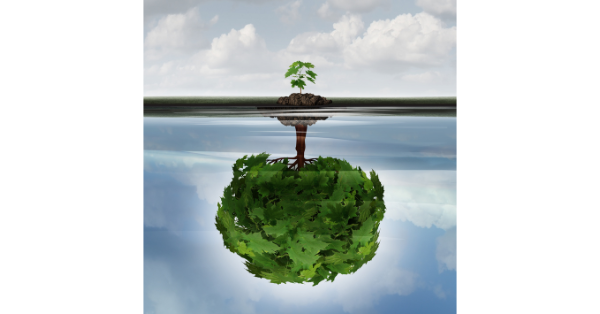LEADERSHIP
When It’s Raining Frogs, An Umbrella Is Not Enough

Change happens slowly, and then… all at once.
Some changes are rather small in the large scheme of things. Some changes we choose. We adapt an existing product or launch a new one. We complete a merger or offload a division in a strategic sale. We consolidate our infrastructure or devolve it. Then there’s change we don’t control, but we can directly influence. We respond to the ups and downs of the market, make adaptations, and once again find stasis.
But sometimes, there’s an absolutely fundamental shift – over which we have no meaningful control. What we do or don’t do doesn’t seem to slow or impact the pace of change. Or, if we are impacting the changes we cannot tell, because the relationship between cause and effect is no longer discernible. Instead of a dilemma, we might be facing a tri-lemma, or quad-lemma. A pandemic combined with domestic political instability, new military conflicts, and a recession is a perfect example.
The trick as a business leader is knowing how to tell the difference between a change in the weather and a pole-shift. In the very early stages, they look similar. But the long-term implications are as different as north is from south.
If there’s rain on the horizon, we grab an umbrella and schedule an indoor lunch instead of a picnic in the park. If the sky is green and raining frogs, we have no meaningful prior experience from which we can draw a best practice to apply. Simply grabbing an umbrella is an insufficient response.
There’s a strong case to be made that the world has reached a fundamental turning point that is unprecedented, perhaps not in history, but certainly in our lifetime. Whether we’re responsible for a regional family-owned business or leading a multi-national enterprise, many are rightly sensing that there are historical forces afoot that will fundamentally impact business as usual going forward.
Some call it the cycle of empire or a “fourth turning”. Others attribute it to the intensified ideological and political struggle between globalism and nationalism. Whatever the case, we all have businesses to run. Markets wait for no one.
What we can say definitively is that the era we are entering will be shaped by volatile, complex, and chaotic forces with which few leaders have real experience and were not taught to contend with in their educational or professional preparation. Also, most of us are leading businesses with systems, strategies, and habits of mind that were built for success in another era – one marked by relative stability, affluence, and for businesses based in the US – near complete cultural, political, and financial hegemony.
Few of us have direct influence over these forces. However, we can prepare now to adapt our leadership, business strategies, systems, and the culture or our organizations for the essential qualities of this new era. This is the first in a series of articles that will explore key ideas and practical strategies that will help businesses not just survive, but thrive in this new era of dramatically increasing complexity.
Here are two important frameworks for understanding the current business environment:
VUCA (Volatile, Uncertain, Complex, Ambiguous):
In an intensely VUCA environment, best practice tools that we have used successfully in the past are still useful, but need to be applied differently as the outcomes of our actions become harder to predict due to the mounting of forces outside our business’ direct control. Yes, we should focus on what we control. But… what we can control gets much smaller in an intensely VUCA environment.
Cynefin Framework (Simple vs. Complicated vs. Complex vs. Chaotic challenges):
This model explains what happens in an intensely VUCA environment. In essence, as the known relationships between cause and effect become more separated by time (complicated), difficult to discern and only obvious in retrospect (complex), or not usefully perceivable (chaotic), different approaches to problem-solving are required – both from internal leaders of a company and from consultants or others engaged to assist them.
The greatest danger that leaders face is continuing to act as if the problem at hand is simple (cause and effect known and repeatable) and apply the same old best practices – when in fact the problem has moved into being complicated, complex, or chaotic. As explained by Dave Snowden in this deeper-dive video, failure to recognize this can mean businesses fall off the “cliff” between simple and chaotic.
The fear of this is what’s behind the anxiety many leaders are feeling. They might not know exactly why, but the fear is justified. They sense that the landscape has fundamentally changed, but they don’t know how what to do about it – beyond continuing to apply strategies that have worked well in the past.
As Dave Snowden says in the video linked above, it is very difficult to recover from falling off the cliff between simple and chaotic. This is a key reason why some businesses failed in a VUCA environment like the pandemic. Some business either froze or kept applying the best practices of the past as the situation became increasingly complex and chaotic. They failed to understand and account for the fundamental change in the landscape, and then came system failure.
This is akin to the man falling from a tall building and all the while saying, “So far, so good!”. An ultra-lean and just-in-time inventory for a manufacturing facility was incredibly profitable in 2019. In 2020, it put some out of business if they didn’t figure how to engineer “slack” back into their system and account for unreliable supply chains.
Things are ok until they aren’t. Things work until they don’t.
Other businesses managed to muddle through COVID, but are culturally and/or financially damaged – because they continue to resist making fundamental adjustments to a fundamentally changed environment. Companies that put off culture building for two years, while people worked from home and waited for things to “return to normal” are now several steps behind competitors who embraced the hybrid workplace and found new ways to build relationships and advance strategic planning without regular in-person gatherings.
Of course, some businesses succeeded financially during the pandemic. Those who happened to own a chain of liquor stores or take-out restaurants likely did great! However, if they didn’t do something fundamentally new on-purpose, that success was largely the luck of the draw.
Most business leaders are well-practiced, educated, and trained to respond to simple and complicated challenges. For simple challenges we just apply the correct and known best practice. For complicated challenges we consult established experts with validated technical expertise on the problem at hand.
However, very few business leaders have been prepared the contend with complex and chaotic environments with the same level of competency. The businesses that thrive on-purpose going forward will recognize that what works in the simple and complicated domains will not work in the complex and chaotic domains.
Simple and complicated problems will persist. But success, who wins and who loses, will be determined by the ability to skillfully respond to the complex and chaotic.
Those businesses that thrived-on-purpose over the last two years learned how to account for all four of the domains above. Success in this new complex and chaotic era will demand changes in three primary areas:
- Leadership (who we choose to lead and develop other leaders)
- Strategy (how we execute in an unpredictable and chaotic business environment)
- Structure (what new, flexible, and “anti-fragile” systems and decision-making processes we implement within our companies designed to withstand and even be strengthened by the presence of greater disorder)
You may also like…

BLOG | FAMILY DYNAMICS / GOVERNANCE
The 4-Letter Word Owners Can’t Afford NOT to Talk About: EXIT
I’ve had my share of family business owners who avoid discussing this four-letter word to the point of pure denial, quickly ending the conversation when this word bubbles up. The word? E-X-I-T. It sounds so final. The brutal truth is that 100% of owners exit the business, yet only 50% – just 1 out of 2 owners – will do it on their terms...
Read More
BLOG | LEADERSHIP
Family Business Peer Groups are Gamechangers for the Next Gen
Many family-led companies hire business consultants to grow the business. Some even send their emerging leaders to personal development programs. But there is a gap – and it’s a BIG one.
Read More
BLOG | PEOPLE / TALENT
Unlocking the Golden 5% in Your Employees
The Golden 5% is the full expression of our ability, multiplied by our maximum possible effort, multiplied by our full contribution of heart. It is the performance equivalent of what we offer in a deeply loving relationship – the absolute best of ourselves. And yet, we rarely give it or reliably inspire the giving of it by others in organizations. Why?
Read MoreWhere Family Businesses Come to Grow & Learn
At Compass Point, we make it easy to get insights, training, tools, and articles straight to your inbox and help family business owners and their team continue to grow, learn, and lead.


